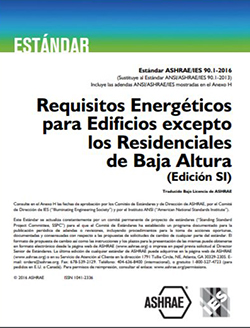Spanish Translation of Standard 90.1 Incorporates
Technical Content Updates
From eSociety, June 2018
The ASHRAE Spain Chapter has translated the 2016 edition of Standard 90.1—a benchmark for commercial building energy codes in the United States and a key basis for codes and standards around the world for more than 35 years—for Spanish speakers.
Estándar ASHRAE/IES 90.1-2016, Requisitos Energéticos para Edificios excepto los Residenciales de Baja Altura (Edición SI), includes significant format, structural and technical content changes.
The 2016 edition of the standard includes energy-saving measures, incorporates changes from more than 125 addenda and features format changes to improve usability and readability.
Format changes include:
-
One-column format for easier reading
-
Exceptions separated, indented, and set apart with a smaller font size
-
Italicized defined terms
-
Changes to table formats to provide contrast between rows
The updated standard underwent to structure changes:
-
A new “Annex 1: Reference Standard Reproduction Annex—ASHRAE Standard 169” is provided at the end of the document. Section 5.1.4 now cites ASHRAE Standard 169 as the source for climatic data, and Annex 1 contains extracts of tables and figures from that standard for the reader’s convenience.
-
Two new climate zones (0A/B) have been added to all prescriptive requirements tables.
The standard’s technical content changes include:
-
Building Envelope
-
Envelope verification in support of reduced air infiltration and increased requirements for air leakage of overhead coiling doors.
-
Increased stringency requirements for metal building roofs and walls, fenestration, and opaque doors.
-
Improved clarity on defining exterior walls, building orientation, fault assumptions for the effective R-value of air spaces, and calculation procedures for insulating metal building walls.
-
Lighting
-
Modified requirements for exterior and interior lighting power densities to reflect new lighting levels in the IES Lighting Handbook.
-
Modified requirements for lighting control to add additional controls in some space types and options to others to allow easier application of advanced controls.
-
Mechanical
-
Large, electrically driven chilled-water plants are now required to be monitored for electric energy use and efficiency.
-
Dedicated outdoor air systems now include both efficiency and rating requirements for compliance.
-
Requirements are introduced for designs to include both use category and efficiency class.
-
Requirement that air-cooled DX cooling units with economizers have a monitoring system to determine that the air economizer is working properly.
The hard copy of the standard will be available at the 2018 ASHRAE Annual Conference in Houston. For more Spanish translations, visit.